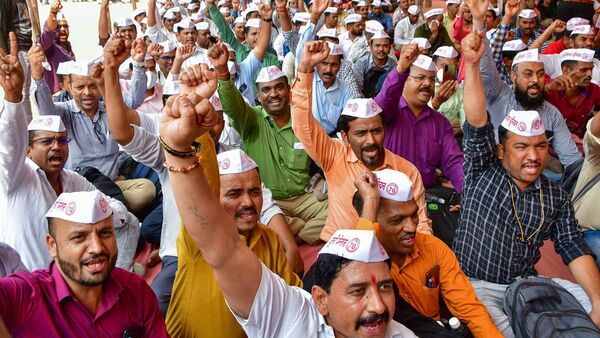It is widely recognised worldwide that pensions for government employees tend to be a populist plank for garnering votes. In India, too, pensions have been more of a political than an economic compulsion.
Some state governments are going back to the old pension scheme (OPS) regardless of the burden it will put on their exchequer. In September 2022, the Punjab government said it was considering reverting back to OPS for its employees. Rajasthan, Chhattisgarh, and Jharkhand have already announced a return to OPS and Himachal Pradesh is also expected to do so.
This trend has reignited national debates on pensions. The central government has not been able to resist the temptation of populism. Giving in to political pressure, the central government on Thursday constituted a four-member committee chaired by finance secretary TVS Somanathan to look into ways of improving the benefits for government employees under the National Pension System (NPS).
Although the centre has said that this committee will ensure that fiscal prudence isn’t compromised, it’s no secret that by the time the panel’s recommendations are ready, the political heat will have turned up ahead of the 2024 Lok Sabha elections. It’s likely then that ways will be found to reverse yet another reform and splurge more tax money on making the pension system populist while presenting the whole affair as fiscally prudent – which it simply cannot be.
Among others, Montek Singh Ahluwalia, a distinguished economist and former deputy chairman of the Planning Commission, has cautioned that going back to OPS will bankrupt the government within 10 years. The OPS was stopped by the BJP-led NDA government in December 2003 because it was not sustainable and the New Pension Scheme kicked in on April 1, 2004. This was a laudable reform.
OPS was rolled out after Independence. Under it, employees with 20 or more years of service get 50% of their last drawn salary plus dearness allowance as their pension for life. Half of that inflation-indexed pension is paid to qualifying dependent family members in case the employee dies. The OPS income of pension receivers is not taxed. There was no corpus out of which OPS pensions were paid. Because it had no funding plan, the government’s liability simply kept growing, making OPS a ticking fiscal time bomb.
Under the NPS, employees contribute 14% of their salary to a pension corpus while the government contributes 10% of employees’ salaries to the fund. Pensions are determined by the returns on the investments made by pension fund managers. In contrast, under the OPS, the government bore the entire expense while workers got a guaranteed pension.
In 2004, the Indian Pension Research Foundation had computed the estimated implicit pension debt at 64% of India’s GDP. An Asian Development Bank (ADB) report estimated the annual fiscal cost of pensions at $30 billion in 2012, up from less than $0.5 billion in the 1980s. According to the Seventh Central Pay Commission report, there was a three-fold increase in pension expenditure from 2007-08 to 2013-14. It also said the government’s contribution to the OPS (excluding Railways) increased from ₹924 crore in 2011-12 to ₹1,600 crore in 2013-14.
India cannot afford higher pensions for government employees, especially with increasing longevity and salaries rising sharply after generous pay commission rewards (these were implanted by making assumptions of high GDP growth, which have not materialised).
So what should the new committee do?
First, it should make public the number of individuals that receive salaries and pensions from the government. It should also specify the number of people who draw pensions and salaries from entities – such as the armed forces, railways or public sector units – that have accumulated losses and depend on the government to make these payments. The total bill for these salaries and pensions footed by the taxpayer should also be disclosed. Public debates on pensions or salaries should not take place in the absence of complete transparency and full disclosures about the extent to which taxpayers are being billed.
Second, there should be a performance evaluation system for appraising government employees on which salary hikes must be based. Information on the performance of every government employee must be publicly accessible by citizens. Rewarding employees regardless of performance needs to end.
The government has been living hand-to-mouth year after year for quite some time. At under 12% for FY23, India’s tax-GDP ratio has not only remained stagnant for many years, it is also lower than that of most major economies. Thus the third area the committee must explore is development versus pensions. Every extra rupee spent on government salaries and pensions is a rupee less for the welfare of the less privileged and for supporting productive sectors of the economy. The committee must estimate the opportunity cost of devoting scarce budgetary resources to government pensioners, a section of society that is neither underprivileged nor the most productive.
Diverting budgetary resources to pensions should not result in the need to borrow more for funding development. Every rupee borrowed by the government is a rupee less for the private sector to borrow and invest. Private investments support sustainable GDP growth. Government pensions and salaries, less so. Plus, the government’s borrowings increase the tax burden on future generations of taxpayers. Apart from fiscal sustainability, the OPS also threatens to worsen intergenerational inequities.
Finally, the committee must lay out a clear plan for funding higher pensions. It has been seen with the Fiscal Responsibility and Budget Management (FRBM) Act that governments do not stick to fiscal consolidation targets. India’s public debt levels are not projected to drop to the FRBM target level of 60% of GDP any time soon. The committee should take into consideration this chronic inability to stick with expenditure control, revenue generation and fiscal consolidation targets when preparing its projections.
Download The Mint News App to get Daily Market Updates.
More
Less
#Indias #creaking #pensions #system #transparency #populism
